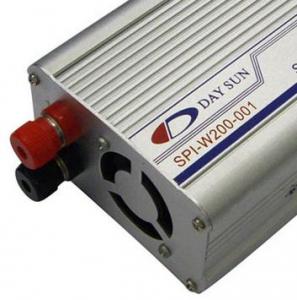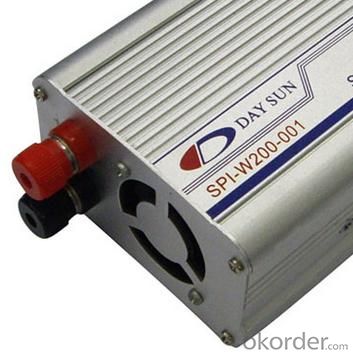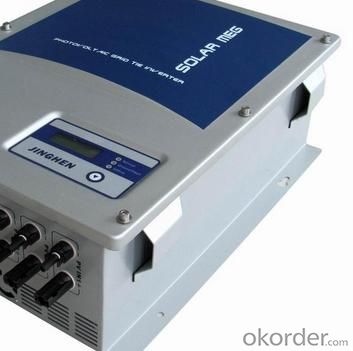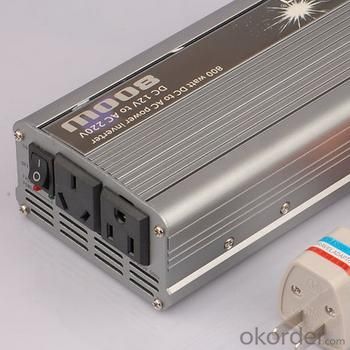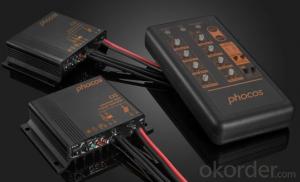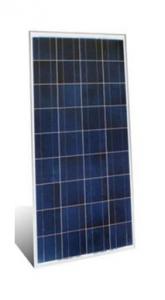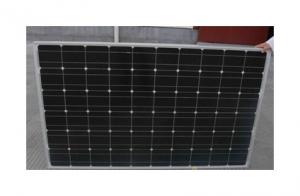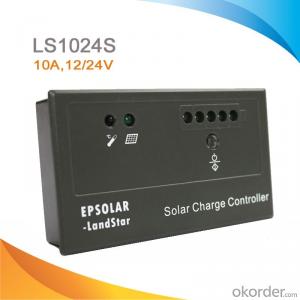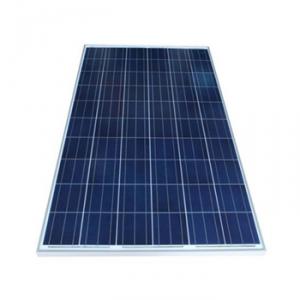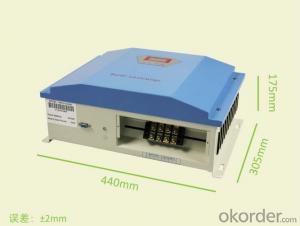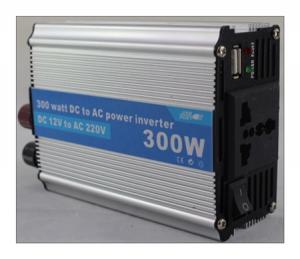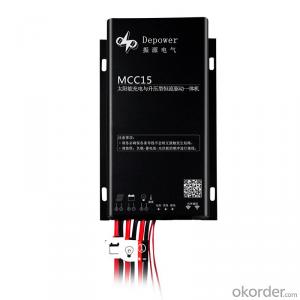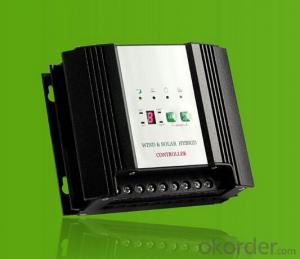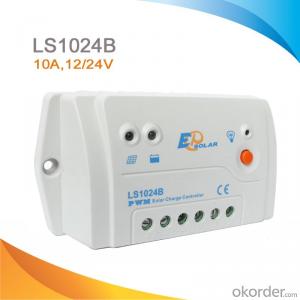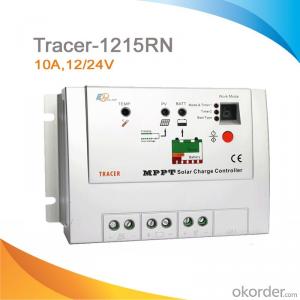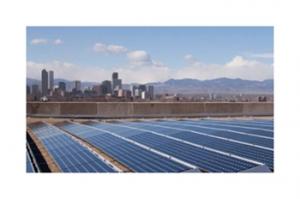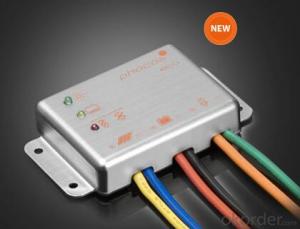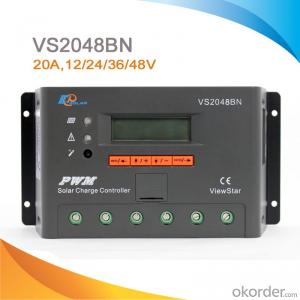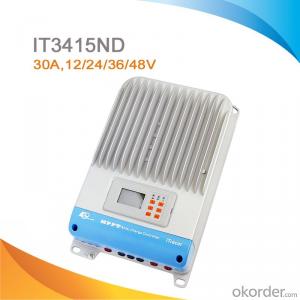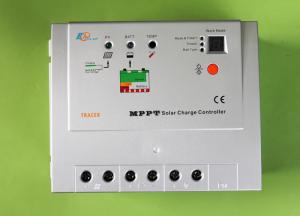Solar Controllers - High Quality 10A 12V Solar Charge Controller with Useful Discharge
- Loading Port:
- China main port
- Payment Terms:
- TT or LC
- Min Order Qty:
- 100 unit
- Supply Capability:
- 10000 unit/month
OKorder Service Pledge
OKorder Financial Service
You Might Also Like
1, Product desciption
Inverter circuits designed to produce a variable output voltage range are often used within motor speed controllers.
The DC power for the inverter section can be derived from a normal AC wall outlet or some other source. Control and feedback circuitry is used to adjust the final output of the inverter section which will ultimately determine the speed of the motor operating under its mechanical load.
Motor speed control needs are numerous and include things like: industrial motor driven equipment, electric vehicles, rail transport systems, and power tools. (See related: variable-frequency drive ) Switching states are developed for positive, negative and zero voltages as per the patterns given in the switching Table.
The generated gate pulses are given to each switch in accordance with the developed pattern and thus the output is obtained.
2, Features of the product
Inverters convert low frequency main AC power to higher frequency for use in induction heating.
To do this, AC power is first rectified to provide DC power. The inverter then changes the DC power to high frequency AC power. Due to the reduction in the number of DC Sources employed, the structure becomes more reliable and the output voltage has higher resolution due to an increase in the number of steps so that the reference sinusoidal voltage can be better achieved.
This configuration has recently become very popular in AC power supply and adjustable speed drive applications. This new inverter can avoid extra clamping diodes or voltage balancing capacitors. There are three kinds of level shifted modulation techniques, namely:
The first thing to figure out is the length of road in need of street lights.
This can be a small entrance road only a couple hundred of feet long to miles of streets through an area. Does the area currently have any type of lighting available.
What is the reason for needing street lights in this area
Is the electrical grid already nearby or would you need to call in the power company to bring in electrical lines.
If the electric needs to be brought to the area, how much is this going to cost? Depending on how far the grid electric is from the location of the needed lighting, this can be quite expensive.
How much lighting is needed on the street? Do the lights need to be dark sky compliant.
Do the street lights need to run from dusk to dawn or for only a specified number of hours at night.
Are the street lights able to dim in the middle of the night and still provide enough lighting.
These questions need to be answered before you can decide on how many lights you will need to complete the project.
3, Detailed Specification
ltem | Description |
Rating Voltage | 1000VDC |
Rating Current | 15A |
Protection Class | CLASSll |
Ambien e Range:t Temperatur | -40℃---85 |
Dust,water level | IP67 |
Sealing | Closed |
Cable Specification | 4mm2 |
Dimension | 104x95x19(mm) |
Certification | TUV/ |
Diode model | SB4040LDC |
Testing standard | BS EN50548;2011 |
Pollution levels | 2 |
Maximum working temperature | 110℃ |
Flame retardant grade | UL94 V-0 |
Bus width | MAX.6.0 mm |
Convergence with the connection | Clamping |
Connector | CABLE |
4, Product Image
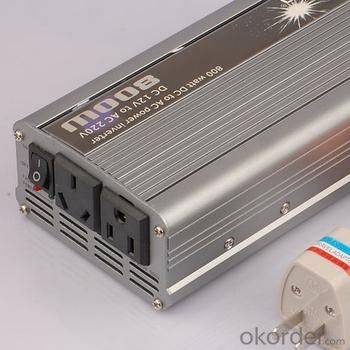
- Q: What is the maximum load temperature a solar controller can handle?
- The maximum load temperature a solar controller can handle varies depending on the specific model and manufacturer. It is important to consult the product specifications provided by the manufacturer to determine the maximum load temperature for a particular solar controller.
- Q: How does a solar controller handle variations in solar panel soiling?
- A solar controller does not directly handle variations in solar panel soiling. Its primary function is to regulate the charge and discharge of the battery connected to the solar panel system. However, it indirectly helps mitigate the effects of soiling by optimizing the performance of the solar panels. By monitoring the voltage and current produced by the panels, the controller ensures that the maximum power point tracking (MPPT) algorithm is employed, which adjusts the panel's operating conditions to extract the most power possible. This helps compensate for any losses caused by soiling and maintain the overall efficiency of the solar panel system.
- Q: How can I determine the size of solar controller I need for my system?
- To determine the size of a solar controller you need for your system, you will need to consider a few factors. 1. Solar panel capacity: Start by calculating the total capacity of your solar panels in watts. This information is usually provided in the product specifications or on the back of the panels. 2. Battery bank capacity: Determine the total capacity of your battery bank in amp-hours (Ah). This information can usually be found on the batteries themselves or in their documentation. 3. Charge current: Next, you need to determine the maximum charge current that your solar panels can produce. This is usually mentioned in the solar panel specifications or user manual. Once you have this information, you can use the following formula to calculate the required solar controller size: Controller Size (in amps) = (Solar Panel Capacity in watts / System Voltage) / Charge current For example, if you have a solar panel capacity of 500 watts and a system voltage of 12 volts, and your solar panels can produce a maximum charge current of 25 amps, the required solar controller size would be: Controller Size = (500 watts / 12 volts) / 25 amps = 1.67 amps In this case, you would need a solar controller with a capacity of at least 1.67 amps to ensure it can handle the charging needs of your system. It's important to note that it's always a good idea to choose a solar controller with a slightly higher capacity than what is calculated to allow for any potential future expansions or increased power demands.
- Q: What is the purpose of the battery temperature compensation feature on a solar controller?
- The battery temperature compensation feature on a solar controller serves the purpose of ensuring optimal charging and discharging of the battery under different temperature conditions. Batteries are sensitive to temperature, and extreme hot or cold temperatures can affect their performance. When exposed to high temperatures, batteries undergo accelerated chemical reactions, resulting in increased self-discharge, reduced capacity, and a shorter overall lifespan. Conversely, extremely cold temperatures can lead to decreased battery efficiency and capacity. To address these temperature-related issues, solar controllers equipped with the battery temperature compensation feature continuously monitor the battery's temperature and make necessary adjustments to the charging and discharging parameters. By accurately measuring the battery's temperature, the controller can determine the appropriate voltage and current levels required for safe charging. During hot temperatures, the compensation feature decreases the charging voltage to prevent overcharging and excessive heat generation, thus safeguarding the battery from potential damage. Conversely, in cold temperatures, the compensation feature increases the charging voltage to counteract the decrease in battery capacity caused by lower temperatures. By adapting the charging and discharging parameters based on the battery's temperature, the battery temperature compensation feature optimizes the battery's performance, prolongs its lifespan, and ensures its safe operation. This feature is especially crucial in solar systems situated in off-grid or remote locations, where batteries are exposed to varying temperature conditions.
- Q: What is the maximum distance between the solar panel and the solar controller?
- The maximum distance that can be maintained between the solar panel and the solar controller relies on several factors, including the wiring type, voltage drop across the span, and the unique specifications of the panel and controller in use. Typically, it is advised to keep this distance as short as feasible to reduce voltage drop and guarantee effective energy transmission. Nevertheless, in the majority of instances, a maximum distance of roughly 100 feet (30 meters) is deemed appropriate for low-voltage solar systems. To ascertain the optimal distance for your particular setup, it is always advisable to refer to the manufacturer's guidelines or consult with a professional.
- Q: Can a solar controller be used with a generator?
- Yes, a solar controller can be used with a generator. The solar controller regulates the charging of batteries from solar panels, and it can also regulate the charging from a generator. By connecting the generator's output to the input terminals of the solar controller, it can effectively manage the charging process and ensure the batteries are charged efficiently.
- Q: Can a solar controller be used with a solar-powered street light?
- Yes, a solar controller can be used with a solar-powered street light. A solar controller is an essential component of a solar-powered street light system as it regulates the power flow from the solar panel to the battery, preventing overcharging and extending the battery's lifespan. It also manages the lighting operation, controlling when the street light should turn on and off based on the battery's charge level. Overall, the solar controller plays a crucial role in optimizing the performance and efficiency of a solar-powered street light.
- Q: How does a solar controller prevent battery discharge during nighttime or low sunlight conditions?
- A solar controller prevents battery discharge during nighttime or low sunlight conditions by automatically detecting the absence of solar energy input and interrupting the flow of current from the battery to the solar panel. This prevents the battery from discharging and helps to maintain its charge levels until sufficient sunlight is available again.
- Q: Can a solar controller be used with solar-powered indoor office buildings?
- No, a solar controller is typically used in off-grid solar systems to regulate and control the flow of electricity from the solar panels to the batteries. In indoor office buildings, the electricity is usually sourced from the grid and supplemented by solar panels. Therefore, a solar controller is not necessary for solar-powered indoor office buildings.
- Q: Can a solar controller be used with solar panel ground racks?
- Yes, a solar controller can be used with solar panel ground racks. A solar controller is responsible for regulating the flow of energy from the solar panels to the batteries or electrical loads. It is not directly dependent on the type or location of the solar panel mounting system, so it can be effectively used with ground racks or any other type of solar panel mounting.
Send your message to us
Solar Controllers - High Quality 10A 12V Solar Charge Controller with Useful Discharge
- Loading Port:
- China main port
- Payment Terms:
- TT or LC
- Min Order Qty:
- 100 unit
- Supply Capability:
- 10000 unit/month
OKorder Service Pledge
OKorder Financial Service
Similar products
Hot products
Hot Searches
Related keywords
